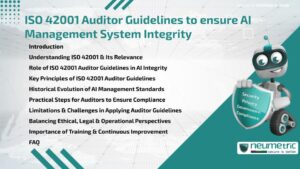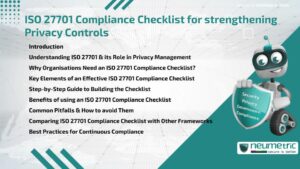Table of Contents
ToggleIntroduction
The National Institute of Standards & Technology Cybersecurity Framework [NIST CSF] is a widely recognised guideline for managing & improving Cybersecurity in Organisations. It provides a structured approach to identifying, protecting, detecting, responding to & recovering from Cyber Threats. In this NIST CSF explained guide, we explore its origins, purpose, structure, benefits, challenges & practical implementation strategies. By understanding its five Core Functions & aligning them with business goals, enterprises can strengthen their security posture without unnecessary complexity.
Understanding the NIST Cybersecurity Framework
At its core, the NIST CSF is a set of Best Practices, standards & guidelines that Organisations can follow to manage Cybersecurity Risks. Unlike prescriptive regulations, it offers flexibility for enterprises of all sizes & industries. This adaptability makes the Framework suitable for both large corporations & smaller businesses looking for structured Risk Management.
Why the NIST CSF Matters for Enterprises?
Cybersecurity Threats are not limited to high-tech firms — every enterprise that relies on digital systems is at Risk. The NIST CSF helps Organisations assess their current security state & plan improvements in a clear, measurable way. This NIST CSF explained approach reduces guesswork & supports compliance with other regulatory requirements.
The Five Core Functions of the NIST CSF
The Framework’s five Core Functions — Identify, Protect, Detect, Respond & Recover — work together like the pillars of a strong fortress.
- Identify: Understanding Assets, Risks & Vulnerabilities.
- Protect: Implementing safeguards to secure systems.
- Detect: Monitoring & discovering Cybersecurity events.
- Respond: Taking action to contain & mitigate Threats.
- Recover: Restoring systems & operations after an incident.
Each function is broken down into categories & subcategories, enabling detailed planning.
Historical Background & Development
The NIST CSF originated in 2014 in response to a United States Executive Order aimed at improving critical infrastructure Cybersecurity. Initially intended for Energy, Transportation & other vital sectors, it has since gained adoption across industries.
How Enterprises Can Implement the NIST CSF?
Implementation begins with a Gap Analysis to determine where an organisation’s current practices differ from the Framework’s recommendations. From there, enterprises set target goals & create an action plan. Common steps include staff training, Risk Assessment, policy updates & technology upgrades.
Benefits of Adopting the NIST CSF
Adoption of the NIST CSF offers several advantages:
- Improved Risk Management & resilience
- Better alignment of Cybersecurity with Business Objectives
- Simplified communication between technical & non-technical teams
- Enhanced trust with partners & customers
These benefits make the Framework a practical choice for enterprises seeking measurable improvement.
Common Challenges & Limitations
While effective, the NIST CSF is not without its challenges. Smaller Organisations may find initial implementation resource-intensive. Others may struggle with ongoing maintenance if leadership commitment is lacking. The NIST CSF explained approach requires cultural as well as technical changes — something that takes time & persistence.
Practical Tips for Ongoing Cybersecurity Improvement
Enterprises can maintain Cybersecurity improvements by:
- Regularly reviewing & updating Policies
- Conducting periodic Risk Assessments
- Providing continuous Employee Training
- Leveraging Threat Intelligence feeds
- Documenting lessons learned from incidents
These measures help ensure that the NIST CSF explained principles remain embedded in daily operations.
Takeaways
- The NIST CSF offers a flexible & effective structure for managing Cybersecurity Risks
- Understanding its Core Functions helps create a stronger security posture
- Historical context reveals its adaptability across industries
- Implementation requires planning, training & technology upgrades
- Awareness of challenges is essential for long-term success
FAQ
What does the NIST CSF focus on?
It focuses on identifying, protecting, detecting, responding to & recovering from Cybersecurity Threats.
Is the NIST CSF mandatory for all Organisations?
No, it is voluntary but widely adopted due to its effectiveness & adaptability.
How often should an enterprise update its NIST CSF plan?
At least annually or after significant changes to systems or Threat landscapes.
Can Small Businesses use the NIST CSF?
Yes, its flexible structure makes it applicable for businesses of all sizes.
What makes the NIST CSF different from ISO 27001?
It is more flexible & less prescriptive, allowing Organisations to tailor it to their unique needs.
Is training necessary for NIST CSF implementation?
Yes, staff awareness & training are critical for successful implementation.
Need help?
Neumetric provides organisations the necessary help to achieve their Cybersecurity, Compliance, Governance, Privacy, Certifications & Pentesting goals.
Organisations & Businesses, specifically those which provide SaaS & AI Solutions, usually need a Cybersecurity Partner for meeting & maintaining the ongoing Security & Privacy needs & requirements of their Clients & Customers.
SOC 2, ISO 27001, ISO 42001, NIST, HIPAA, HECVAT, EU GDPR are some of the Frameworks that are served by Fusion – a centralised, automated, AI-enabled SaaS Solution created & managed by Neumetric.
Reach out to us!





